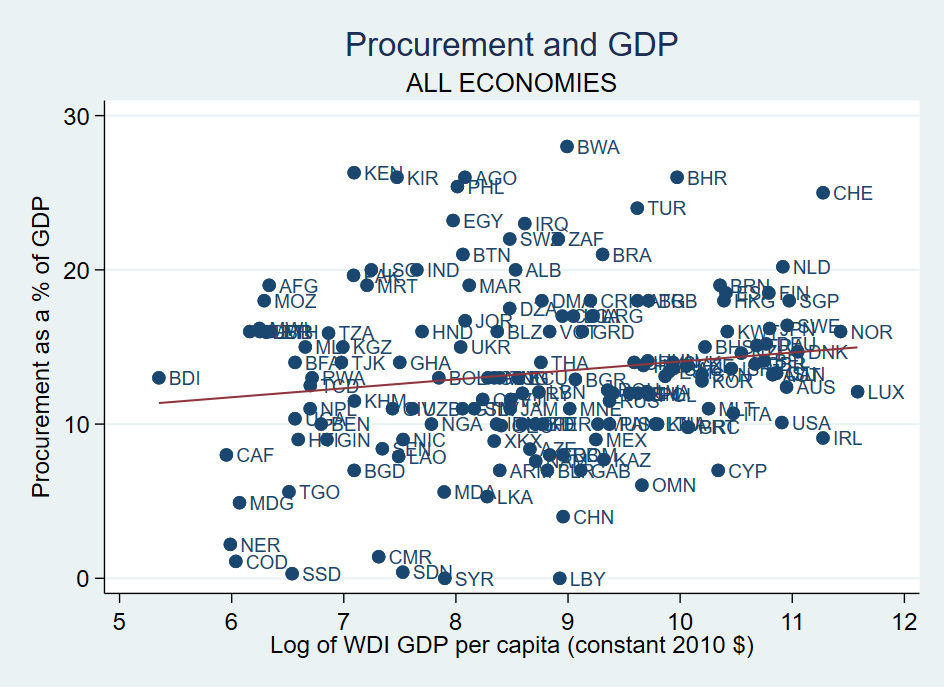How large is public procurement?
Public procurement — the process by which governments purchase goods, services and works from the private sector — amounted to $11 trillion out of global GDP of nearly $90 trillion in 2018. In other words, 12 percent of global GDP is spent following procurement regulation.
The regulation of public procurement is relatively new. With the exception of Japan in 1947 and the United States two years later, most countries adopted procurement laws in the 1990s or 2000s. This legislative activity was informed by the model procurement regulation that the United Nations Commission on International Trade Law made available in 1994. The regulation on the books in many countries is consequently similar, though in practice may differ. An ongoing research project with professors Edward Glaeser and Andrei Shleifer at Harvard University aims to document these differences.
The size of public procurement as a share of GDP is nearly identical across low-income, middle income and high-income countries. Among the 190 countries that we have studied, low-income economies procure on average 13 percent of GDP in goods, services and works. Middle-income countries procure 13.2 percent of GDP and high-income countries procure 14 percent of GDP. These differences are statistically insignificant.
There are large differences within income groups, however. Botswana, a middle-income country, procures 28 percent of GDP (figure 1). In Sri Lanka, another middle-income country, that figure is only 6 percent. Kenya, a low-income country, procures 26 percent of GDP; Madagascar — only 5 percent. Our research is focused on finding patterns across countries in terms of their proclivity to use procurement regulation.
Figure 1: Twelve percent of GDP globally is spent on public procurement

Source: Own calculations based on government data and World Bank Group staff estimates.
Note: These procurement data may not cover military expenditures and sectors like healthcare, as these are sometimes incurred through special procurement regulation or direct awards. The actual size of public procurement is likely larger.
For example, we match data on the size of public procurement as a share of GDP with the Freedom House 2018 index to see whether accountable governments rely more on public procurement. The answer is yes, they do, although this relationship is statistically insignificant. The average share of public procurement to GDP is over 14 percent in high accountability countries, 13 percent in medium accountability countries and less than 12 percent in low accountability countries. European countries tend to have a large share of public procurement in GDP: 25 percent in Switzerland, 20 percent in the Netherlands, 19 percent in Finland, and 16.5 percent in Sweden, for example. So do a number of large emerging economies: Brazil, Egypt, India, Pakistan, South Africa, Turkey and Vietnam all procure over 20 percent of GDP. The size of procurement expenditure in these groups of countries reflects a larger engagement by the government in providing goods, services and works.
Fragile states often have a small share of public procurement to GDP, reflecting the limited ability of governments to deliver services. In 2018, for example, Yemen, Niger, Cameroon, the Democratic Republic of Congo, Sudan and South Sudan each spent less than 5 percent of GDP through general procurement procedures.
These data — collected by contacting the relevant procurement agencies or statistical offices — complement existing World Bank data on the overall size of public expenditure. The method of these expenditures varies across countries and even across sectors within a country. Procurement regulation offers a level of transparency and competition that is typically higher than alternative methods of direct awards to private contractors, works and services implemented by state-owned enterprises, or sector-specific rules that limit competition. The data is made publicly available as part of the Contracting with the Government indicator of the Doing Business project.
